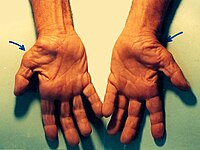
Photo from wikipedia
Carpal tunnel syndrome (CTS) is a most common peripheral nerve entrapment neuropathy characterized by sensorimotor deficits in median nerve innervated digits. Block-design task-related functional magnetic resonance imaging (fMRI) studies have… Click to show full abstract
Carpal tunnel syndrome (CTS) is a most common peripheral nerve entrapment neuropathy characterized by sensorimotor deficits in median nerve innervated digits. Block-design task-related functional magnetic resonance imaging (fMRI) studies have been used to investigate CTS-related neuroplasticity in the primary somatosensory cortices. However, considering the persistence of digital paresthesia syndrome caused by median nerve entrapment, spontaneous neuronal activity might provide a better understanding of CTS-related neuroplasticity, which remains unexplored. The present study aimed to investigate both local and extensive spontaneous neuronal activities with resting-state fMRI. A total of 28 bilateral CTS patients and 24 normal controls were recruited, and metrics, including amplitude of low-frequency fluctuation (ALFF) and voxel-wise functional connectivity (FC), were used to explore synaptic activity at different spatial scales. Correlations with clinical measures were further investigated by linear regression. Decreased amplitudes of low-frequency fluctuation were observed in the bilateral primary sensory cortex (SI) and secondary sensory cortex (SII) in CTS patients (AlphaSim corrected P < .05). This was found to be negatively related to the sensory thresholds of corresponding median nerve innervated fingers. In the voxel-wise FC analysis, with predefined seed regions of interest in the bilateral SI and primary motor cortex, we observed decreased interhemispheric and increased intrahemispheric FC. Additionally, both interhemispheric and intrahemispheric FC were found to be significantly correlated with the mean ALFF.
Journal Title: Neurorehabilitation and Neural Repair
Year Published: 2017
Link to full text (if available)
Share on Social Media: Sign Up to like & get
recommendations!